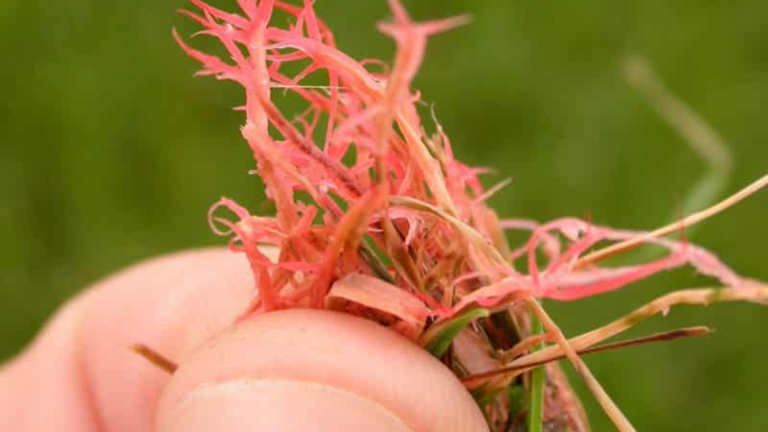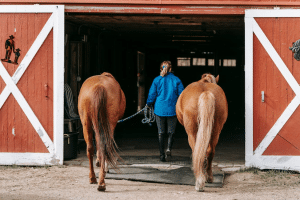I noticed something strange in my lawn. Some patches of grass looked faded, almost pink or red. At first, I thought it was just dry or sunburned. But then I looked closer and saw tiny red threads sticking out from the grass blades. That’s when I learned about red thread lawn disease.
This common lawn problem shows up in spring or fall, especially when the weather is damp and cool. It doesn’t mean your whole lawn is dead, but it is a sign that your grass isn’t healthy.
In this blog, I’ll show you what red thread looks like, how to spot it early, and what you can do to help your lawn bounce back. If your grass appears off, this simple guide can help you determine if red thread is the cause. Let’s get started.
What Is Red Thread Lawn Disease?

Red thread is a type of lawn fungus. It gets its name from the thin, red or pink threads that grow on grass blades. These threads are not part of the grass—they are the fungus itself. The disease usually shows up during cool, wet times like spring or fall.
It’s most common in lawns that are low on nitrogen. That means your grass isn’t getting enough of the food it needs to grow strong and green. When grass is weak, it’s easier for fungus to take over.
The good news? Red thread does not kill the roots of your grass. So even if it looks bad, your lawn can recover.
What Does Red Thread Look Like?

It can be hard to spot the red thread at first. Many people think their grass is just dry or sun-damaged. But the red thread has some clear signs to look for:
- Pink or Reddish Patches: You’ll see spots of grass that look faded, pink, or red. These patches can be small or large. They might look like someone spilled pink powder on your lawn.
- Thin Red Threads: If you bend down and look closely, you’ll see fine red or pink strands sticking out from the tips of the grass blades. These threads are what give the disease its name.
- Grass Blades Sticking Together: In some cases, the red threads can stick grass blades together. It almost looks like the blades are webbed.
- Tan or Bleached Grass: As the fungus spreads, some grass may turn tan or light brown. This makes the lawn look patchy or sick.
What Causes Red Thread?
Red thread is caused by a fungus called Laetisaria fuciformis. This fungus lives in the soil and waits for the right conditions to grow. Here’s what helps it spread:
- Cool and Damp Weather: Red thread grows best when it’s between 60°F and 75°F (15°C to 24°C). It also loves moisture. So, if the weather is cool and rainy, the fungus may start to grow.
- Low Nitrogen in Soil: Grass needs nitrogen to stay strong and green. When your lawn doesn’t get enough nitrogen, it weakens. That gives the red thread a chance to take over.
- Poor Drainage: Lawns with poor drainage hold water for too long. That creates a wet environment, which is perfect for fungus to grow.
- Thick Thatch Layer: Thatch is a layer of dead grass and roots that sits on top of the soil. A thick thatch layer holds moisture and blocks air. This helps the red thread grow.
- Overwatering: Watering too much, especially at night, can leave the grass wet for too long. That’s a welcome mat for red thread.
When Does Red Thread Happen?
Red thread usually shows up in spring and fall, when the weather is cool and damp. It grows best when temperatures are between 60°F and 75°F (15°C to 24°C). If your lawn stays wet for long periods, like after lots of rain or overwatering, red thread can start to grow.
Even in summer, if it’s mild and your lawn stays moist, you might see signs of red thread. It’s most common when your grass isn’t getting enough nitrogen, which keeps it strong and green.
So, if you notice pink or red patches during these seasons, red thread could be the cause.
Is Red Thread Harmful?
Red thread looks bad, but it doesn’t kill your lawn. It only affects the blades of grass, not the roots. That means the grass can grow back once the problem is fixed.
But the red thread is still a sign that your grass is not healthy. It usually means your lawn needs more nutrients, especially nitrogen. If you don’t take care of it, the disease can spread and worsen the appearance of your yard.
So while it won’t kill your grass, red thread is a warning that your lawn needs help.
How to Check for Red Thread?
A simple way to check if your lawn has red thread:
- Look for patches of grass that look faded, pink, or red. These patches can be small or large.
- Get close to the grass: You may notice tiny red or pink threads protruding from the tips of the blades. That’s the fungus.
- Check how the grass feels: The threads can sometimes make the grass feel sticky or give it a webbed appearance.
- Think about the weather: Has it been cool and rainy? That’s when the red thread likes to grow.
- Note the pattern: The red thread appears in uneven patches, not in large, solid areas like those caused by drought or dog spots.
If you spot these signs, it’s likely red thread.
How to Treat Red Thread?
You don’t always need chemicals to treat red thread. In most cases, your lawn will recover on its own if you take care of it the right way. The best ways to treat it are:
- Fertilize Your Lawn: Use a high-nitrogen fertilizer to help your grass grow stronger. When grass is healthy, it can fight off red thread on its own. A slow-release fertilizer works best.
- Water at the Right Time: Water early in the morning. This gives the grass time to dry out during the day. Avoid watering in the evening—wet grass overnight can help fungus grow.
- Mow Often and the Right Way: Keep mowing, but don’t cut the grass too short. Short grass gets weak and stressed. Also, bag your clippings if the red thread is active. This helps keep the disease from spreading.
- Improve Drainage: If your lawn holds water after it rains, you may need to fix the drainage. Add soil, reshape the land, or use drainage pipes to keep things dry.
- Dethatch Your Lawn: Thatch is a layer of dead grass that builds up between the soil and green grass. Too much thatch holds water and blocks air. Use a rake or dethatching tool to clear it out.
When to Use Fungicide?
You don’t always need fungicide for red thread. It often clears up with better lawn care. But if it keeps coming back or covers a large area, fungicide can help.
When it makes sense to use it:
- You’ve already fed your lawn and improved drainage, but red thread is still spreading.
- You’ve had red thread multiple times in the same season.
- You’re seeing more and more damage, and the lawn isn’t getting better.
Look for a fungicide labeled for red thread or lawn fungus. Read the label and follow the instructions carefully. Water the lawn after applying, if the directions say to do so.
Fungicide should be a last resort, not your first step. Try improving your lawn’s health first.
How to Stop Red Thread from Coming Back?
Once your lawn is healthy again, you can take steps to prevent red thread from returning. Here’s what I do:
- Feed Your Lawn Regularly: Use a balanced fertilizer a few times a year to keep your lawn healthy. This keeps the grass strong and well-nourished.
- Aerate the Soil: Use a core aerator once a year to loosen the soil and improve its structure. This lets water, air, and nutrients reach the roots.
- Cut the Right Way: Don’t cut your grass too short. Try to keep it around 2.5 to 3.5 inches tall, depending on the type of grass you are using.
- Watch the Weather: If the forecast calls for cool and wet conditions, keep a close eye on your lawn. Reduce watering and mow the lawn frequently.
Red Thread vs Other Lawn Problems
It’s easy to mix up red thread with other lawn issues. Here’s how to tell them apart:
| Problem | What It Looks Like | When It Happens | Key Signs | Main Cause |
|---|---|---|---|---|
| Red Thread | Pink or red patches with fine red threads | Cool, damp weather (spring/fall) | Thin red threads, webbed grass tips | Low nitrogen, wet grass |
| Brown Patch | Large, round brown spots with dark edges | Warm, humid weather (summer) | Circles of dead grass may smell musty | Too much water, high humidity |
| Dollar Spot | Small, round, tan spots (like silver dollars) | Warm days, cool nights | Spots 1–3 inches wide, brown leaf tips | Low nitrogen, moisture stress |
| Rust Disease | Yellow-orange dust on grass blades | Late summer to early fall | Dust rubs off on shoes or the mower | Dry soil, low nutrients |
| Drought Stress | Grass turns yellow or brown evenly | Hot, dry weather (summer) | Grass feels dry; footprints stay on the grass | Not enough water |
| Dog Urine Spots | Yellow or brown spots with green edges | Anytime pets use the lawn | Dark green ring around a dead center | High nitrogen in dog urine |
Conclusion
Red thread lawn disease can look scary at first, but it’s not the end of your lawn. The good news is that this problem is easily fixable with the right care. If you see pink or red patches in your grass, don’t worry. It just means your lawn needs a little help.
This fungus shows up when the weather is cool and damp. It also prefers grass that doesn’t receive enough nitrogen-rich food. By feeding your lawn, mowing it right, and watering in the morning, you can help it grow strong again. Most lawns bounce back without needing any chemicals.
Red thread is a sign that your lawn is weak, not dead. Once you treat the cause, your grass will start to grow healthy and green. Keep an eye on your yard in spring and fall to stay ahead of potential problems. With a few simple steps, your lawn will look great again. Just give it time and care.













